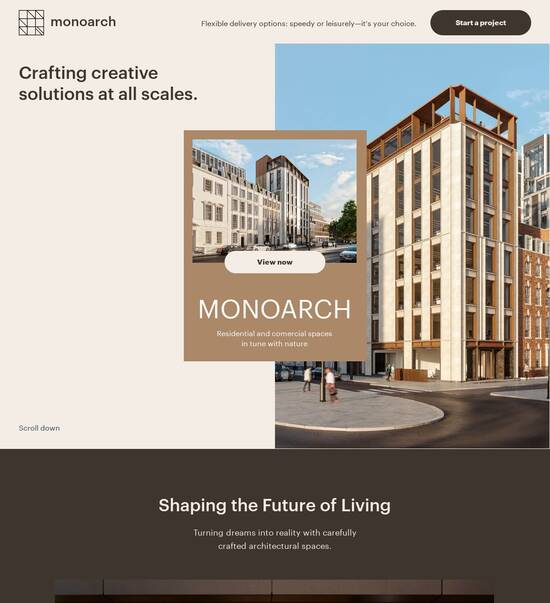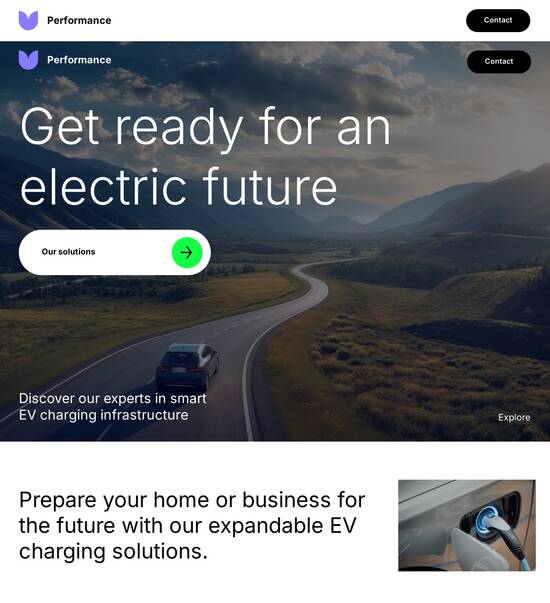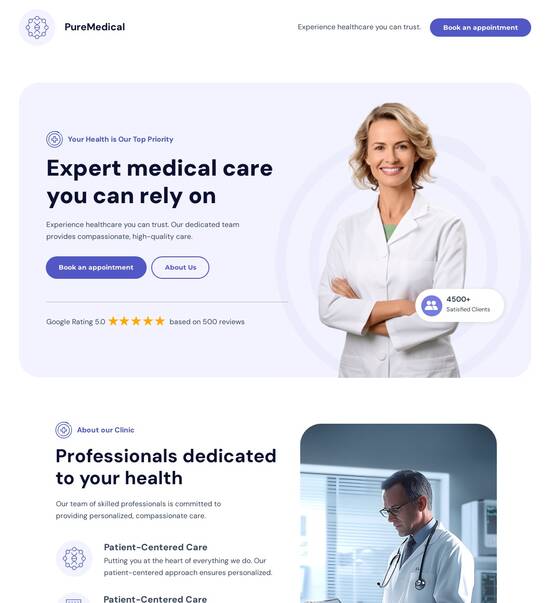
Website Template for 3D Printing Companies
Explore Similar TemplatesAbout template
Create customized landing pages with 500+ conversion-focused layouts and tools for optimization, personalization, and collaboration. Empower your marketing efforts and drive higher conversions with ease.
Recommended templates

Easy to build without coding
With the intuitive drag-and-drop builder, anyone on your team can create high-converting pages without any knowledge of code or design. Make enhancements to your landing page with custom widgets using Javascript, HTML/CSS, or third-party scripts.

Multiple layouts for any industry and goal
Select from 500+ landing page layouts built to boost conversions across industry-specific scenarios. Customize them by adjusting fonts, adding images, and generating on-brand content with the AI assistant. Quickly scale with Instablocks® and Global Blocks that you can save, reuse, and update globally.

Loads fast and looks polished on any device
Every template is responsive, which means they present professionally on any device and load blazingly fast with our Thor Render Engine. You can also power them up with Google AMP technology to deliver an unparalleled mobile experience and drive higher conversions.

Robust analytics & experimentation
Get real-time updates and reporting across all your devices, showing the number of visitors, conversions, cost-per-visitor, and cost-per-lead. Launch AI-powered experiments, run A/B tests, and use heatmaps to analyze user behavior, then optimize your landing page to maximize conversions.







Easy to build without coding
With the intuitive drag-and-drop builder, anyone on your team can create high-converting pages without any knowledge of code or design. Make enhancements to your landing page with custom widgets using Javascript, HTML/CSS, or third-party scripts.
Multiple layouts for any industry and goal
Select from 500+ landing page layouts built to boost conversions across industry-specific scenarios. Customize them by adjusting fonts, adding images, and generating on-brand content with the AI assistant. Quickly scale with Instablocks® and Global Blocks that you can save, reuse, and update globally.
Loads fast and looks polished on any device
Every template is responsive, which means they present professionally on any device and load blazingly fast with our Thor Render Engine.
Robust analytics & experimentation
Get real-time updates and reporting across all your devices, showing the number of visitors, conversions, cost-per-visitor, and cost-per-lead. Launch AI-powered experiments, run A/B tests, and use heatmaps to analyze user behavior, then optimize your landing page to maximize conversions.
All the features you need to build 3d printing website templates
Explore more featuresLearn how to build website templates for printing companies
Frequently asked questions about 3d printing website template
Leading the way in building high-performing landing pages





Printing company website templates: Your ultimate how-to guide
Instapage empowers 3D printing companies to effectively capture leads and maximize conversions. With powerful tools for landing page creation and conversion rate optimization, this all-in-one platform ensures your marketing strategies yield impressive results.
Why choose Instapage for your 3D printing marketing?
Instapage stands out due to its user-friendly interface and extensive library of high-converting templates specifically designed for various industries, including 3D printing. Here’s why it’s the best choice:
- High-quality templates: With over 100 customizable templates, 3D printing businesses can find designs that resonate with their brand, ensuring a professional look without the need for coding.
- A/B testing capabilities: Optimize your landing pages to improve conversions by testing different layouts, images, and calls-to-action with built-in A/B testing features.
- Personalization options: Use dynamic text replacement to align messaging with specific ads, tailoring content to the visitor's needs.
Step 1: Choose the right template for your 3D printing campaign
Begin by selecting a template that best fits your campaign goals. Think about your audience's preferences and the specific services you offer. Follow these steps:
- Browse the template library: Filter templates that are designed explicitly for tech or engineering services.
- Preview the templates: Ensure that the layouts showcase your 3D printing products or services effectively.
- Customize as needed: Take advantage of drag-and-drop elements to align the design with your brand.
Step 2: Optimize for conversion
After selecting your template, focus on optimization to ensure visitors convert. Consider these key elements:
- Call-to-action buttons: Place strong CTAs strategically throughout the page to encourage sign-ups or inquiries.
- Visual elements: Use high-resolution images of your 3D printing work to engage potential customers visually.
- Analytics tracking: Leverage Instapage’s analytics features to monitor how well your landing pages perform.
Step 3: Collaborate and launch
With your landing page crafted, utilize collaboration tools within Instapage to gather feedback. This ensures that every detail aligns with your campaign objectives.
- Share with stakeholders: Allow team members to review and provide feedback on the landing pages before publishing.
- Real-time edits: Make instant modifications based on feedback, enhancing the quality of your final product.
- Launch campaigns: Once approved, launch your 3D printing campaigns confidently.
By following these steps, you’ll be equipped to create powerful landing pages that boost your 3D printing business's online presence and lead generation efforts.
Start maximizing your marketing efforts today. Explore what Instapage can do for your 3D printing company!
People also ask about printing services website template
Website templates for 3D printing companies
The evolution of online presence for 3D printing companies
The 3D printing industry has witnessed exponential growth in recent years, driven by advancements in technology and increasing applications across various sectors. From prototyping to custom manufacturing, companies are seizing the opportunity to leverage this innovative technology. In this rapidly evolving market, establishing a robust online presence is crucial for both startups and established businesses. An effective website serves as a digital storefront, allowing companies to showcase their capabilities, attract new clients, and engage with existing customers.
Having a strong online presence not only enhances credibility but also allows companies to tap into a global clientele. With consumers increasingly turning to the internet for information, a professionally designed website transforms how 3D printing companies engage with their target audience. Whether it's providing information about services, facilitating inquiries, or showcasing portfolios, an effective website is essential for growth and sustainability.
Identifying unique needs of 3D printing businesses
3D printing companies have distinct characteristics that set them apart from traditional businesses. Unlike conventional manufacturers, these companies often focus on a wide range of services, including custom prints, rapid prototyping, and large production runs. As such, the online platform needs to highlight this diversity effectively to cater to various customer needs. Prospective customers must easily understand the unique offerings available, from bespoke designs to scale production capabilities.
Visual content plays a pivotal role in the 3D printing industry. High-quality images and videos help to effectively showcase the complexity and beauty of the prints and designs. Since many customers may have limited knowledge of the technology, providing clear visual representations not only demonstrates capabilities but also helps build confidence. A website template designed for 3D printing companies must prioritize the integration of visual content that effectively communicates the value proposition and expertise.
Website template essentials for 3D printing companies
When crafting a website template for 3D printing companies, certain key features should be prioritized to enhance brand identity and functionality. Customizable layouts allow companies to tailor their online presence meaningfully while adapting to their visual branding. Additionally, high-quality image support is essential; showcasing detailed prints can significantly influence customer decisions, emphasizing the importance of using vibrant images.
Equally important is the responsive design, which ensures that the website performs seamlessly on mobile devices as well as desktop computers. Given that an increasing number of users browse on mobile, having a responsive website is no longer optional but a requirement. A well-optimized template can adapt beautifully across different screen sizes without compromising user experience.
Customizable layouts that reflect brand identity.
High-quality image support to showcase a professional portfolio.
Responsive design for optimal viewing on any device.
Specific functionalities tailored for 3D printing services
Beyond aesthetic aspects, specific functionalities are paramount for engaging potential customers and facilitating orders. A project showcase, for example, allows companies to present various past works while illustrating capabilities and styles. This section acts as a portfolio that entices new customers by demonstrating proven success in previous projects.
User-friendly inquiry forms are essential in the customer journey. These forms should be easily accessible and allow visitors to easily engage with the company, ask questions, or request a quote. Furthermore, implementing e-commerce capabilities streamlines the process for customers looking to place orders directly from the website. This feature not only enhances customer convenience but also promotes the efficient handling of service requests and builds stronger client relationships.
Integrated project showcase for potential customer orders.
User-friendly inquiry forms to facilitate customer engagement.
E-commerce capabilities for direct ordering of prints.
Designing an engaging portfolio section
A well-structured portfolio section is integral to any 3D printing company’s website. This area not only showcases the company's past projects but also communicates creativity and expertise. Strategies for presenting 3D prints include using image galleries and sliders to create an interactive experience that highlights unique aspects of each project. Making the viewing experience engaging encourages visitors to browse longer and learn more about the capabilities offered.
Incorporating case studies further enhances the portfolio by illustrating varied applications of the services provided. These case studies serve as concrete examples of how the company has solved client problems or brought their visions to life. Adding client testimonials and feedback provides additional credibility and builds trust with potential customers, highlighting the company’s commitment to quality and satisfaction.
Optimizing user experience: layout and navigation
User experience greatly influences how effectively a website converts visitors into clients. Intuitive navigation is critical; having a menu structure that clearly addresses services, showcases the portfolio, and shares the company’s story keeps users engaged and informed. Complicated navigation can frustrate users and lead to higher bounce rates, making simplicity vital. Intuitive paths guide visitors effortlessly through the site, helping them find the information they need.
Call-to-action buttons strategically placed throughout the website create a sense of urgency and encourage interaction. These buttons can direct users to submit inquiries, access the portfolio, or even start an order. Implementing a clear visual hierarchy not only enhances layout but also guides the visitor's journey through the website, ultimately increasing engagement and conversion rates.
Building a compelling team page
A team page that showcases the expertise behind the 3D printing services adds a personal touch to the website. Profiles featuring brief bios and professional backgrounds of team members establish credibility and familiarity with potential clients. Customers are more likely to trust a company that provides insights into who will be handling their projects.
Highlighting specialized skills across various printing technologies emphasizes the company’s depth of knowledge. It’s also imperative to portray the support team as friendly and approachable. Providing contact information for team members invites communication, which is crucial in addressing customer inquiries and ensuring that clients feel valued.
Providing comprehensive support and engagement options
A website should effectively communicate the customer support features available to visitors. Offering an informative FAQ section addressing common inquiries about 3D printing services enhances user experience and minimizes potential roadblocks. The contact options provided—chat, email, and phone—must be easily accessible, ensuring immediate assistance when needed.
Incorporating educational resources, such as blogs and tutorials, allows companies to engage their audience further. Providing insights into 3D printing innovations, industry news, and guides on how to order or work with designs not only positions the company as a thought leader but also educates clients about the technology. This continual engagement fosters trust and maintains a connection with clients.
Enhancing visibility and discoverability
To thrive in the competitive 3D printing landscape, companies must integrate effective search engine optimization (SEO) strategies into their website templates. Focusing on keywords that are relevant to the 3D printing industry will improve discoverability in search engine results. This includes optimizing website content with strategic placements of keywords while ensuring that the prose remains natural and engaging.
Alongside SEO, social media integration is vital for expanding reach. Sharing portfolio work across various platforms drives traffic back to the website, creating opportunities to engage with a broader audience. Regular updates and promotions on social media not only keep current followers informed but also attract potential customers to the company’s website.
Importance of keywords relevant to the 3D printing industry.
Optimizing website content to appear on search engine results.
Sharing portfolio work across platforms to drive traffic.
Analyzing success metrics and feedback
Tracking website performance is fundamental for understanding customer engagement. Utilizing analytics tools helps 3D printing companies gain insights into visitor behavior, revealing which sections drive interest and which may need improvement. This data is invaluable for refining service offerings and enhancing the user experience, ensuring that visitors find what they need quickly and easily.
Furthermore, gathering feedback through customer surveys or testimonials provides qualitative insights that can guide future enhancements. Understanding client perspectives on website usability and content can lead to continuous improvement. This feedback loop ensures a constant alignment with customer preferences, contributing to increased satisfaction and loyalty.
Future-proofing with evolving 3D printing technologies
As 3D printing technologies continue to evolve, companies must adapt their websites to remain relevant. This adaptation includes incorporating new technologies, such as augmented reality, to provide interactive visualizations of prints. This cutting-edge approach allows potential customers to visualize their projects before committing, enhancing the overall customer experience.
Keeping website templates updated with the latest design trends is equally important. A fresh and modern aesthetic can significantly influence visitor perceptions, making the company appear innovative and in tune with current market demands. Companies that proactively adjust their online presence will solidify their relevance and sustainability in the 3D printing space.
Conclusion: transforming the future of customer interaction for 3D printing companies
The continuous evolution of website templates has a profound impact on how 3D printing businesses operate and interact with customers. Companies that leverage tailored solutions for their online presence can enhance customer engagement, trust, and satisfaction. As the 3D printing landscape grows, so too must the strategies for online representation, ensuring that all potential clients receive the best information and service.
In summary, a well-designed website template that caters specifically to the 3D printing industry is fundamental for companies looking to remain competitive. By incorporating the key features discussed, businesses can effectively establish their online presence, drive conversions, and foster long-lasting customer relationships.
Ready to skyrocket conversions?
Supercharge your ad campaigns with high-performing landing pages
Get started














